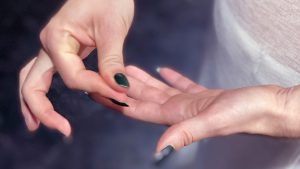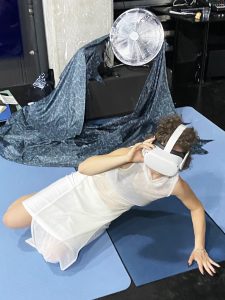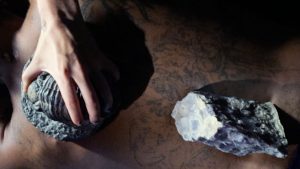From the 21st to the 25th of August 2023, Projekt Atol hosted the Omsk Social Club and a program of workshops and lectures for the 18 participants who came together in Ljubljana to Live Action Role-Play, aiming to build and inhabit an alternative world in the context of a changing planetary ecology.

Participant holding ARIA, photo by Aleksandra Vajd
Welcome to ARIA, a world that is layered on top and unfolds in parallel with our base reality, in an unspecified and alternative future. It is a possibility space and an ambience, one that has existed before we arrived but that is adapted to our input and needs and has a malleable ideological and architectural potential. ARIA stands for Algo-Rhythmic Ideation Assembly. A more graspable description was developed during a one-week summer school program that took place in Ljubljana, during the heatwave in the last week of August 2023 facilitated by Project Atol and developed by Tjaša Pogačar and Brandon Rosenblum.
Both descriptions stand correct. ARIA consisted of a closed-door workshop, and a publicly accessible program in the form of a two-day series of lectures and panels which took place in Cukrarna, a repurposed sugar factory and leading contemporary art space in Ljubljana. The public program was a theoretical dive into the possibility of world-building and anthropoforming, through the presentation of the artistic practices and research of the invited lecturers. The projects presented were diverse with an overarching theme of adjusting the anthropocentric narrative of artistic expression via speculative world-building and performative science fiction. Most of the artists present took cues and inspiration from the organizational logics of contemporary network technologies often in dialogue with plant species or natural environments, integrating alternative perspectives in their world crafting strategies.
Perhaps the most obvious example was the sole Slovenian representative Špela Petrič, a new media artist with a background in the natural sciences and a focus on organic matter. She spoke of her performative ethnographies and work with multi-species relations, introducing the audience to the term »multi-body perspective«. Her practice is based on making art that caters to either plant species or a speculative future population, re-appropriating scientific methodology and exiting the notion of »generative art« where »nothing is actually questioned«. Her works speak of the »desire for transformation, for continuing the act of play as transformation of the real – a desire for becoming with and becoming otherwise.«
Petričes methodology happened to be questioned by the Romanian performance artist and activist Florin Flueras, an ARIA mentor and essential speaker yet outlier in the lack of a digital dimension to his work. He wondered if Petričes projects, that use AI to play with plants, that integrate and cater to plant matter rather than human bodies, were not torturing the plants displayed and harvested for biometric data. Using software lifted from precision agriculture seems to subvert the very »multi-body perspective« Petrič was addressing, potentially distancing from the original notion of cultivating empathy and kinship for the multitude of non-human bodies but rather focusing on the part that re-contextualizes scientific methodologies. Despite the doubt cast over the effects on the subjects in focus, the »curiosity-driven AI« which pivots towards unusual plant dancing rather than quantitative surveillance-driven AI transcends semantic reframing.
Lívia Nolasco-Rózsás, a curator of digitally mediated spatial exhibitions and researcher of the »virtual condition«, would certainly agree as she described the sticky algorithms that co-curate the adapting online exhibitions according to what art pieces would most please and intrigue the individual visitors. In this case, a heavily criticized personalization algorithm is applied differently, refreshing its possible uses. These projects show the reappropriation of algorithms and recontextualizing of bodies as »an ontological play, escaping a fixed set of rules.«

ARIA participants during the public program at Cukrarna, photo by Zupanov
In the spirit of recontextualizing bodies, let’s return to Flueras and a concept and practice that was also developed with the purpose of freeing the body from cliches and automatisms enabling a different type of world-building and a floating set of rules. It is called the »dreaming body« or the »second body«, a hypothetical duplicate of the physical body, one that cultivates a different type of experience. Opening an alternative set of eyes and questioning the »hierarchy of realities« is not far from Špela and Lívias aim, regardless of medium. He spoke of a series of performances developed alongside the late Alina Popa titled Unsorcery, with the goal of ‘unworlding’ and detaching from the preconceived notion of the art space, performance art, the base body, and the senses. According to Flueras though, whether the body you experience and affect reality through is your primary one or your »dream body«, it is still very much a human body.
Flueras himself was criticized as a mentor for not transcending the anthropocentric view; in a closed-door discussion, he was unable to affirm that humans can ultimately perceive through a non-human cognitive model or umwelt, no matter how many projects dedicated to art for fish eyes, algae or bean stalks are developed. Which ideologically clashes with most of the participants who were interested in ARIA in the first place. But here we are, immediately faced with the classic question when trying to warp reality through bodily practices (the performance) and cognitive practices (the speculative theory and science fiction) – the question of complete immersion up to the point of transcendence and the bleed that inhibits this potentiality.

ARIA participant during Simon Speiser’s AR workshop, photo by Aleksandra Vajd
Bleed is a term that refers to the spillover of traits, physicality, and values from the player or base body to the avatar character and vice versa. Bleed is usually defined and used very literally in the context of gameplay, but I think it can also be used more abstractly, as an obstacle to the possibility of moving beyond our human materiality and perceptions. Can we eliminate anthropocentric bleeding in forming a society that integrates a variety of more-than-human consciousness, including technological, in the understanding of future cosmology?
During the private program of ARIA the literal bleed proved more of an issue, as an abstract future zoomed out was easier to embody than the avatars of our choice. The private program and closed-door workshop was the flip side of the theoretical presentations, the actual world-building process breathing life into ARIA, anchored in live-action roleplaying, experiential immersion, and collaboration: LARPing. Why someone might want to be part of such an experience was difficult for me to explain to my friends and family; in our base reality, engaging in such performative exercises is considered absurd, unnecessary and perhaps even self-indulgent. In practice, the activity of Real Game Play should transcend the label of a hobby or experimental contemporary art practice insofar as it works towards solving the »crisis of imagination and ecology«. Or solving the crisis of imagination first, potentially followed by the crisis of ecology. Unwordling and world-building are thus necessary phases of the same process. The construction of ARIA was based in unlearning and unbinding the entrenched structures of our current cognitive perceptions of the reality in which this article is being written to clear space for something different.
We – the 18 participants of the live-action role-play or Real Game Play – originated from diverse localities and backgrounds, the details of which were unknown to the characters that lived during ARIA. The participants came to ARIA in the role of our intuitively preconceived characters, ideally with objects, accessories, and memories that rooted our character’s existence. Our experience was fascilitated by the Berlin-based OMSK Social Club collective, whose work is creating spaces where immersive and durational Real Game Play takes place, sometimes on a massive format. Real Game Play is a methodology developed by the Berlin-based OMSK Collective as a process of speculative worlding through collective immersion. Through this activity, a portal is built into a fictional reality or a yet unlived future, with the purpose of inhabiting the world on the other side.

Participants in play, ARIA, photo by Aleksandra Vajd
The members of ARIA came up with rituals, traditions, history and ways of relating to each other that existed beyond archetypes and learned habits, attempts our characters gently enabled and encouraged. Many of the rituals were physical, based on proximity, touch, and sonic expression, with some players propelled out of their regular comfort zones but quickly finding their way in this new land. ARIA members ranged from a blueberry trapped in a white woman trapped in an arab man’s body called Myrrh or sometimes Blue Berrymore, the volcano Tunupa who got unjustly pinned to the earth and became a lake of her own unconsumed breast milk and tears, Vora who has a damaged memory alongside unrequited cannibalistic tendencies, and a creature made of soil, blood, sweat, rare-earth minerals, silicone, and light called simply M. There were hardly any humans in ARIA, a remarkable and unexpected fact, said one of the initiators of the program. But that is what I mean by saying the abstract future is much easier to embody and problems arise when trying to eliminate the bleed with our base realities of the now. To deepen our experience and life as a member of ARIA, we tried to unlearn our base body expectations, projections, and senses by interacting as these other-then-human consciousnesses, wanting (and failing) to stay so deeply in character and immersed that the bleed is no more, to become one with our new mind feeling the body following in sync. Some of the artists who presented their practice in Cukrarna also led workshops during the closed-door program of ARIA, guiding us through different exercises to further the ARIA project.

Protectorama Toxica during the closed-door workshop in ARIA, photo by Marijn Degenaar
One of these mentors, an artist who fully incorporates bleed, is JP Raether and the project of aLifveForms, a decade-long ongoing performance consisting of three main alter identities or self-sisters weaving research, language, and »techno-alchemy«. The tribe of witches he embodies form a genealogical tree that can be tracked on a smooth website, an archival feat that is an integral part of the performance, complete with geolocations and photographs documenting the avatar’s appearances. The avatars appear in spaces like an Ikea in Germany, a mountain top in Scotland or a street in Johannesburg, in the act of »comuneering«; engineering a community while showing how in any common reality another reality is always present. The term »surrogate witch« resonates with the idea of the »dream body«. The appearance of the »surrogate witch«, in this case, Protectorama Toxica, the selfsister who graced ARIA, and her integration into our common perception of reality is a seamless experience. JP Raether can discuss Protectorama Toxica, and Protectorama Toxica can reffer to JP Reather and the other selfsisters. There doesn’t seem to be much acting involved, channeling might be a better description, and there is obvious bleed on a literal as well as abstract level, which contrary to expectations makes the ongoing rotation of performances real and effective. Makeup, accessories and avatars as technologies of social transformation achieving a potent conceptual and optical daydream, or rather »daydreaming while accounting for materiality«. Base reality and this other speculative reality are equally present, enmeshing and even accentuating each other.
This loops us back to the most effective and pleasurable part of ARIA worlding, the action of the ritual. All the rituals we conceived brought us together and made ARIA seem real, and our community tangible. The ritual might be drinking from a special ARIA concoction, linking pinkies and melting into a mass of bodies, buzzing so close together we could sense our collective vibrations. Finally, the most potent ritual of reading our secret blessings, is dedicated to ourselves, our character, our base body or someone we love. The blessing part was presented to us as a »psycho-social ritual« and initiated by our mentor and public program speaker, the video artist Shubash Thebe Limbu. He presented his science-fiction documentary Ningwasum in Cukrarna, and then a part of it again to us privately. The film speaks of time travel, the interlacing of multiple temporalities, resistance and ritual. He mingled ancestral knowledge with future technologies, forming a weirdly relatable way of meshing the past, the future and the now, so unstable and distant and unbelievably bizarre. His talk and the casting of blessings we did, first writing them down and then reading them aloud to a fully silent and focused room of fellow ARIA members, illuminated how essential it is to conceive of new rituals, aimed to set the ground for a world we want to build — no matter how untidy and confounding this process may be.

Blue Berrymore and two ritual objects, photo by Aleksandra Vajd
——————————————————————————————————————————————————–
If you want to know more about Klara Debeljak and her practice aside from LARPing, get in touch with her through her Instagram account.
This article was originally commissioned and published by The Makery, a platform aiming to cover the dynamism and give out information on the creative communities and the scene of labs, fablabs, makerspaces, hackerspaces, medialabs, living labs, biohacklabs, artlabs, foodlabs and other “third spaces”.
——————————————————————————————————————————————————–

